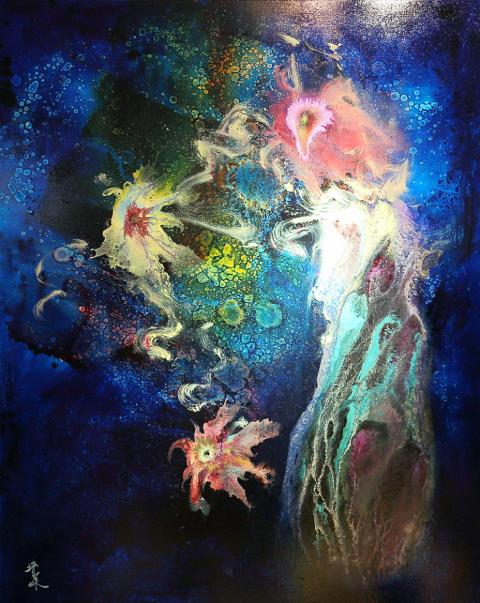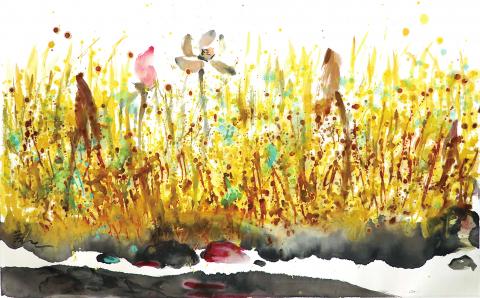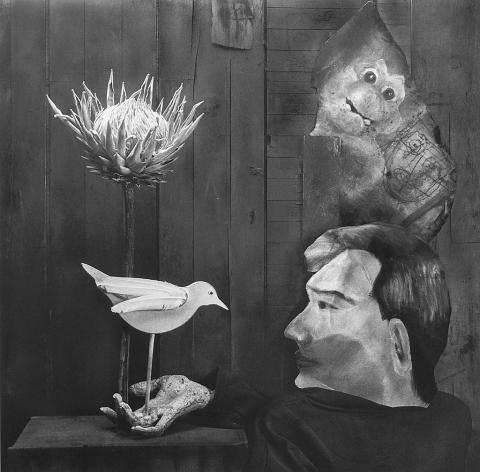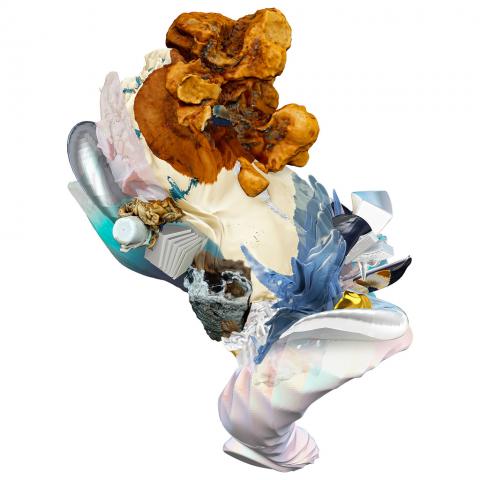Netherlands-based British photographer Eric Kellerman is fascinated by the female form — in the nude, of course — and has a team of female models that he works with. His latest solo exhibition, The Box (箱中的活字版人體結構), is currently on view at Taipei’s 1839 Contemporary Gallery. The exhibition features Kellerman’s signature female nudes, but this time, they are all striking dance, acrobatic and yoga poses inside of boxes. According to his Web site, Kellerman considers his work to be “distant” and “unerotic” — though that’s really up to the viewer to decide, isn’t it?
■ 1839 Contemporary Gallery (當代藝廊), B1, 120 Yanji St, Taipei City (台北市延吉街120號B1), tel: (02) 2778-8458. Open Tuesdays to Sundays from 11am to 8pm
■ Until May 1

Photo courtesy of Aura Gallery
Chiu Chien-jen’s (邱建仁) bleak, mysterious paintings of silhouettes and cityscapes are currently on display at Taipei’s Lin & Lin Gallery. Once I Gaze At (他處) centers around the idea of the omniscient gaze. Chiu favors grayish and deep blue hues, with a dabbling of maroon here and there. The point of view appears to be rather fatalistic, something which is conveyed through the listless motions of Chiu’s subjects. In some instances, people merge into the landscape, becoming one and the same, symbolizing the impermanence of human life.
■ Lin & Lin Gallery (大未來林舍畫廊), 16, Dongfeng St, Taipei City (台北市東豐街16號), tel: (02) 2700-6866. Open Tuesdays to Sundays from 11am to 7pm
■ Until May 1

Photo courtesy of In River Gallery
I’m a native English speaker and I had to look up the word “oneiric.” Apparently, it means “relating to dreams.” Oneiric Subjectivity (夢.主體 ) is Hong Kong-born, Taiwan-based sculptor Lai Chi-man’s (黎志文) latest exhibition. While Lai’s previous work contained hidden political messages, he takes on a more abstract, poetic approach this time, using materials as diverse as marble, lead and iron to create sculptures that are supposed to replicate the feeling of being in a dream-like state. Lai pays careful attention to curvature and movement in his sculptures, which is not an easy feat with the materials he uses. The result is that the reader gets lost in his alternative world where dreams rule supreme.
■ ArtDoor Gallery (藝境畫廊) 639, Ruiguang Rd, Taipei City (台北市瑞光路639號), tel: (02) 2658-5268. Open Tuesdays to Sundays from 11am to 7pm
■ Until May 8

Photo courtesy of In River Gallery
Artist and poet Brigitta Rossetti has an ideal space for inspiration: a converted old barn in the Italian countryside. Her paintings, sculptures and collages all pay tribute to her love of flowers, butterflies and animals but they also allude to the frailty of human life. In fact, Rossetti’s work has a very literary, romantic feel, from the ruffles in the leaves and flower petals to the elongated stems. Her latest solo exhibition, I Fiori e il Sogno (Flowers and Dreams), opens tomorrow at Taipei’s Bluerider Art.
■ Bluerider Art (藍騎士藝術空間), 9F, 25-1, Renai Rd Sec 4, Taipei City (台北市仁愛路四段25-1號9樓), tel: (02) 2752-2238. Open Tuesdays to Saturdays from 9am to 6pm
■ Opens tomorrow. Until May 21

Photo courtesy of In River Gallery
Opening tomorrow at Aura Gallery Taipei is The Essence of Things (靜相), a joint exhibition that explores the dark side of the human subconscious through depictions of flowers, birds and other pretty things. It includes Tainan native Wu Chuan-lun (吳權倫) who uses mixed media — computer generated images, carvings and paintings — to create three-dimensional-like rainbow shapes. Also in the lineup is Chinese artist Yin Zhaoyang (尹朝陽) who is known for his expressionist landscape paintings, as well as South African-based American photographer Roger Ballen whose frightful-looking black-and-white photographs depict marginalized and unstable people. Seriously, why can’t flowers just be pretty things that we all like to look at?
■ Aura Gallery Taipei (亦安畫廊台北), 313, Dunhua N Rd Sec 1, Taipei City (台北市敦化南路一段313號); tel: (02) 2752-7002. Open Tuesdays to Saturdays from 12pm to 7pm
■ Opens tomorrow. Until May 21

Photo courtesy of Aura Gallery
Yet another floral-themed art exhibition is making its debut tomorrow. You would think that galleries would come up with more original themes to mark the beginning of spring, but Blooming in the Orient (花/非花), to be held at Taipei’s In River Gallery, looks promising as it boasts an impressive lineup of Taiwanese artists. Included in the exhibition are Chen San’s (塵三) colorful, tranquil paintings that combine Western impressionism with the finesse and structure of Chinese brush paintings. Chen lives at the foot of the mountains in Taipei and his oil paintings are rich in earthy greens and dreamy violet hues. Chou Chen (周宸) prefers deeper, more evocative hues. The thick, punctuated brush strokes of his oil paintings create a feeling that is at once peaceful and intense, mimicking how one feels when in the presence of untouched nature. Yu Chuan (堉泉) prefers a slightly psychedelic palette to paint his mythical creatures intertwined with flowers and other nature habitats.
■ In River Gallery (穎川畫廊), 2F, 45, Renai Rd Sec 1, Taipei City (台北市仁愛路一段45號2樓), tel: (02) 2357-9900. Open Tuesdays to Sundays from 1pm to 8pm
■ Opens tomorrow. Until June 8

Photo courtesy of Aura Gallery

This is the year that the demographic crisis will begin to impact people’s lives. This will create pressures on treatment and hiring of foreigners. Regardless of whatever technological breakthroughs happen, the real value will come from digesting and productively applying existing technologies in new and creative ways. INTRODUCING BASIC SERVICES BREAKDOWNS At some point soon, we will begin to witness a breakdown in basic services. Initially, it will be limited and sporadic, but the frequency and newsworthiness of the incidents will only continue to accelerate dramatically in the coming years. Here in central Taiwan, many basic services are severely understaffed, and

It is a soulful folk song, filled with feeling and history: A love-stricken young man tells God about his hopes and dreams of happiness. Generations of Uighurs, the Turkic ethnic minority in China’s Xinjiang region, have played it at parties and weddings. But today, if they download it, play it or share it online, they risk ending up in prison. Besh pede, a popular Uighur folk ballad, is among dozens of Uighur-language songs that have been deemed “problematic” by Xinjiang authorities, according to a recording of a meeting held by police and other local officials in the historic city of Kashgar in

Jan. 5 to Jan. 11 Of the more than 3,000km of sugar railway that once criss-crossed central and southern Taiwan, just 16.1km remain in operation today. By the time Dafydd Fell began photographing the network in earnest in 1994, it was already well past its heyday. The system had been significantly cut back, leaving behind abandoned stations, rusting rolling stock and crumbling facilities. This reduction continued during the five years of his documentation, adding urgency to his task. As passenger services had already ceased by then, Fell had to wait for the sugarcane harvest season each year, which typically ran from

The People’s Republic of China (PRC) was out in force in the Taiwan Strait this week, threatening Taiwan with live-fire exercises, aircraft incursions and tedious claims to ownership. The reaction to the PRC’s blockade and decapitation strike exercises offer numerous lessons, if only we are willing to be taught. Reading the commentary on PRC behavior is like reading Bible interpretation across a range of Christian denominations: the text is recast to mean what the interpreter wants it to mean. Many PRC believers contended that the drills, obviously scheduled in advance, were aimed at the recent arms offer to Taiwan by the